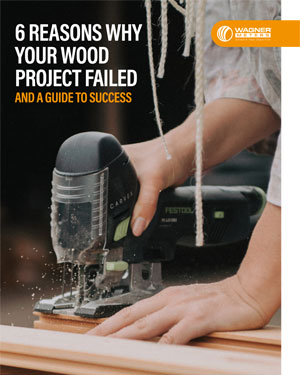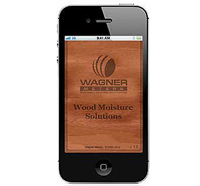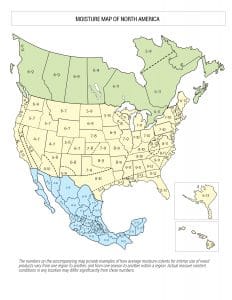Temperature’s Impact on Wood Moisture Content
If you want to take accurate wood moisture measurements you need to understand how the ambient temperature, relative humidity, and wood moisture content interact.
But that’s not all.
You also need to understand how temperature affects your wood moisture meter. This is because pin-type and pinless meters are not affected in the same way by temperature. We’ll talk more about this in a bit. But first, let’s go over some basics about temperature and wood moisture content.
- How Does Temperature and Humidity Affect Wood?
- Relative Humidity and Wood Moisture Content
- How Does Moisture Affect Wood
- How Temperature Affects Your Wood Moisture Meter
How Does Temperature and Humidity Affect Wood?
First of all, what do we mean when we talk about the moisture content of wood? Let’s quickly go over the answer to that before we continue.
The moisture content of wood equals the weight of the water present in the wood divided by the weight of wood without the water times 100 to put into a percentage. Note that it’s possible for the moisture content to be over 100% if the water present in the wood weighs more than the wood itself.
Now let’s talk about how temperature and humidity affect wood…
Relative humidity has a greater impact on moisture content than ambient temperature. This is because the temperature only indirectly influences wood’s moisture content via its influence on the relative humidity.
Here’s what we mean…
If we were to do a climate control test and place a piece of wood (let’s say a piece of wood flooring) in an environment where the temperature increases and decreases while the relative humidity level stays constant, there will only be a very small moisture measurement change.
However, if the same flooring sample is placed in an environment where the temperature remains constant, but the relative humidity increases and decreases, the moisture measurement readings will rise and fall accordingly. You can see this for yourself by looking at an equilibrium moisture content (EMC) table.
So, why does relative humidity have a greater impact on moisture in wood than temperature? Let’s find out.
Relative Humidity and Wood Moisture Content
Wood is a hygroscopic material. This is just a fancy way of saying that wood is constantly reacting to environmental climate change by absorbing and releasing moisture. In other words, wood is continually moistening and drying.
Here’s how this works…
If the EMC of the air is higher than it is in the wood, the wood will absorb moisture from the air until the two are in balance. That is until both the air and the wood have the same moisture content. The reverse is also true.
Wood will release moisture into a dry environment until both the air and the wood are in balance. This balance point where the wood is neither absorbing or releasing moisture (i.e., drying) is called the EMC.
So, it’s the relative humidity, not the temperature, that significantly changes the moisture content of wood.
Prior to putting down hardwood flooring, building a cabinet, or any other project, wood needs time to adjust to the environment where it will be finally used. In other words, it needs time to reach EMC. Failure to do this could result in moisture-related deformities later because wood shrinks when its moisture content decreases (drying) and swells when its moisture content increases.
We’ll go into more detail about this in the next section. But, before we do that let’s talk a bit more about how water gets into wood.
Water gets into wood via water vapor passing through cell lumens (i.e., cavities), via molecular diffusion through cell walls, and via something called capillary tension. Everyone reading this has probably seen capillary tension in action.
For example, if you roll up a paper towel and stick it into a glass of water, you’ll see the water draw up into the paper towel. This is happening because of capillary tension. It’s the same way water moves from a tree’s roots into the trunk and eventually up into the leaves.
How Does Moisture Affect Wood
Moisture content directly affects wood’s physical dimensions. This is because the natural give-and-take process with the surrounding relative humidity that we talked about earlier, causes wood fibers to either swell or shrink in size.
If dried wood isn’t allowed to properly acclimate to the location where it will be finally used, this natural give-and-take process will continue even after the project is complete.
This can lead to gaps, buckling, crowning, splits, or other problems, depending on the type of project.
Let’s talk about this in more detail…
Wood is anisotropic.
Anisotropic just means that as wood absorbs and releases water it contracts and expands in different ways along its three planes: tangential, radial, and longitudinal (i.e., along the grain).
For example, as wood dries, it shrinks an average of 8% along the tangential plane. However, the shrinkage in the radial direction averages only about 4%. Finally, the shrinkage along the grain is only from 0.2-0.4%.
Wood’s density affects shrinkage and expansion.
Denser species of wood show greater moisture-related shrinkage and expansion than lighter density species.

Free Download – 6 Reasons Your Wood Project Failed
Dry wood is stronger than wet wood.
All species of wood get stronger as they’re dried. Wood with a moisture content from 12-15% has about twice the bending and compression strength of freshly cut wood. Dried wood’s tensile strength reaches its peak when the moisture content is from 6-12%.
Wood doesn’t like excessive moisture and high humidity levels.
Wood prefers dry conditions. When the temperature is between 0-40C and the wood moisture content remains above 20% for an extended period of time, wood will start to get moldy. In these situations, the relative humidity level is usually over 80%. Once the relative humidity level exceeds 90% under these conditions, wood will start to rot as well.
However, in sub-zero temperatures, even 85% relative humidity isn’t a problem because it’s too cold for fungus to grow.

How Temperature Affects Your Wood Moisture Meter
If you’ve read this far you have a basic understanding of how relative humidity, temperature, and wood moisture content interact. This knowledge will help you accurately measure moisture content in wood regardless of the weather conditions.
Also, our Wood H2O app will help you quickly determine the correct EMC for any wood project. This ensures that your project — whatever it may be — won’t experience moisture-related problems after construction or installation.
Now let’s talk about how temperature affects your wood moisture meter…
Pin-type wood moisture meters
Pin-type meters are sensitive to changes in wood temperature because of the technology they use.
Pin meters take moisture content readings by passing an electrical current between the pin tips and measuring the resistance. However, as the temperature of the wood increases, its electrical resistance decreases and this, of course, affects the moisture content reading.
Therefore, if you want an accurate reading you’ll need to correct for this temperature-related skew. Most pin meters come with instructions on how to do this.
Pinless wood moisture meters
Because pinless wood moisture meters don’t rely on electrical resistance to determine the wood moisture content, you don’t need to correct them for temperature (except in temperature extremes).
Also, relative humidity in the air doesn’t significantly affect moisture content readings taken with pinless meters unless there’s condensation on the meter. Even surface moisture on the wood itself isn’t a problem for Wagner pinless meters because our IntelliSense™ technology enables the meter to “see past” it.
As you can see…
If you want to prevent moisture-related problems with your wood projects, you’ll need to take accurate moisture readings. However, taking accurate wood moisture readings depends on understanding how relative humidity, temperature, wood moisture content, and your particular moisture meter’s technology interact.
As you embark on your next construction or renovation project, understanding the moisture content in wood building studs is pivotal. Dive into our feature article, ‘Watch Moisture Content in Wood Building Studs,’ to ensure your structures stand the test of time with integrity and safety.
Tony Morgan is a senior technician for Wagner Meters, where he serves on a team for product testing, development, and also customer service and training for moisture measurement products. Along with 19 years field experience for a number of electronics companies, Tony holds a B.A. in Management and his AAS in Electronics Technology.
Last updated on October 23rd, 2024





What is the relationship between relative humidity of air, say 60%, and wood say 12%, which is pretty common in my shop. I run a dehumidifier, which maintains the shop humidity at 60%, and I use a microwave to dry my lathe turning projects to 12-14 percent?
Hi Arnold,
To best answer your question I’ll refer you to the following calculator and chart: http://www.csgnetwork.com/emctablecalc.html
Hope this helps you.
Hi,
In the last paragraph you speak about temperature extremes in relation to moisture measurement with pinless moisture meter.
What do you mean with temperature extremes? what is the temperature above which a pinless moisture meter won’t be reliable anymore?
Thanks,
Alex
Hi,
I was reading the various postings and have a similar but unique question/problem.
We kiln dry our wood to approximately 10%, both 1″ and 2″ thickness. We are using Teak.
We are located in an areas that is exceptionally wet and humid this time of year, 95% humidity is a normal day right now.
Once the wood is removed from the kiln, how long will it take for the current humidity to increase the lumber MC to above the 10% target?
If we are putting the wood into production within a couple of weeks of leaving the kiln, are we ok? Or should we be storing the wood in a climate controlled area of some sort until it is used?
It is our assumption that the issue is less of a problem once the wood is finished and sealed.
Thanks,
Ken Phillips
Hi Ken,
The wood will move up in moisture quickly at 95% RH, so should be stored in a controlled environment, but I suggest that they use their moisture meter to their advantage, and take readings immediately out of the kiln (but after the wood has cooled a bit), and then take readings every 24 hours for the next few days to determine the ramp rate.
Help!!!
Trying to acclimate some flooring and the crawl space to an appropriate level. It’s been three months. The wood is mahogany. It came in at 5% and I cannot get it to rise in the house. RH in the house has been between 35 and 45. Geothermal unit heats and cools the house.
The crawl space suffered an accident with a drain in March. Dehumidifier has been installed after clean up and encapsulated process. The RH is down to 55, and the temp is at 60. I believe a lot of this is due to the geo system is duct worked throughout the house. The drain actually drains under the house also. I was told to close off the outside vents which I did. At the time in Indiana it was hot and humid. The floor plywood is coming down. The main issue is getting the new wood above 5. Any suggestions would be helpful. Wood has been stored in the house for 3 1/2 months.
Today the outside temp was at 15 and the RH was 28. Would it be wise to open the crawl to this outside air to help speed the process under the house.
Thanks!!!!
John and Cathy
Hi John, This sounds like something we should discuss over the phone. Give us a call at (800) 634-9961 and we’ll be happy to help you out.
I have a quick question. We are forming some plastics using a wood mold. How much affect does a wood mold have in forming our product? Thank you.
Hi Ramiro,
I’m not entirely sure how we can be of help. Can you provide some more information as to what you’re working on? Please feel free to give Customer Service a call at 1-800-634-9961 to provide additional information. Thanks!